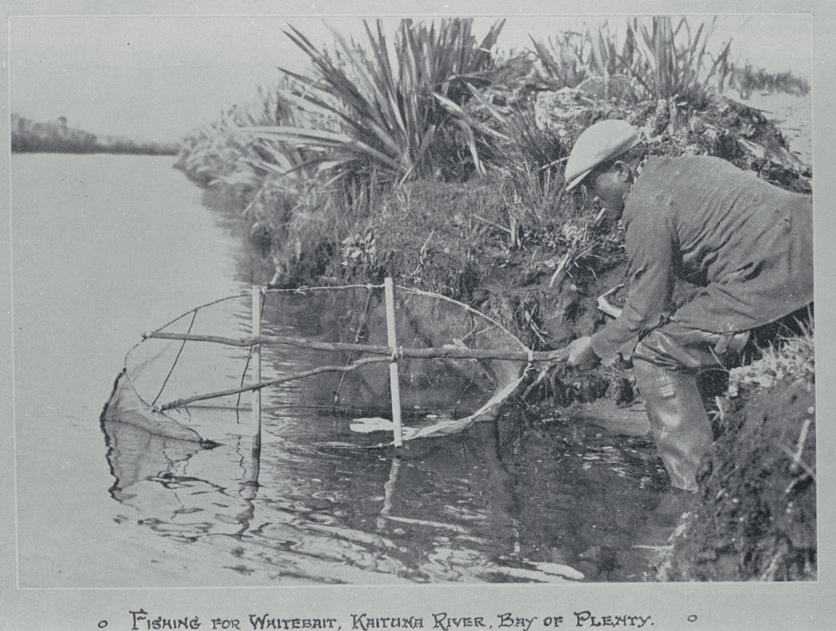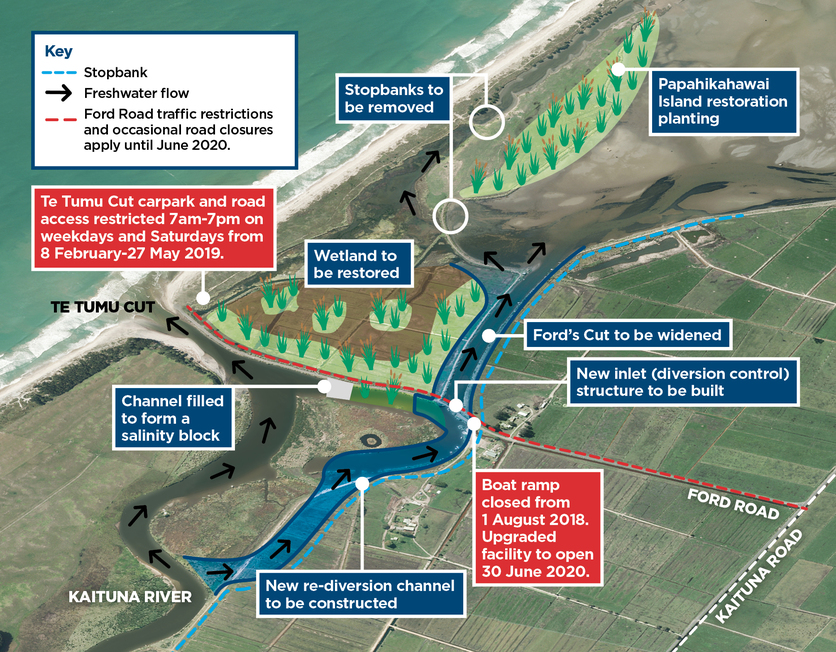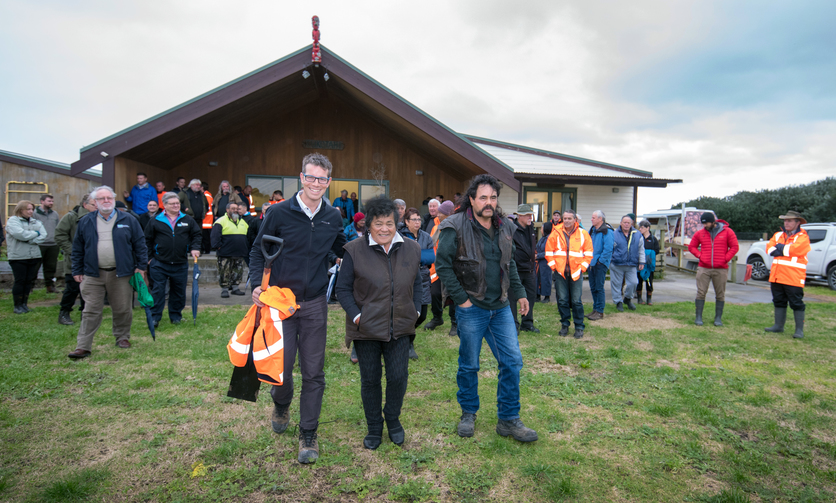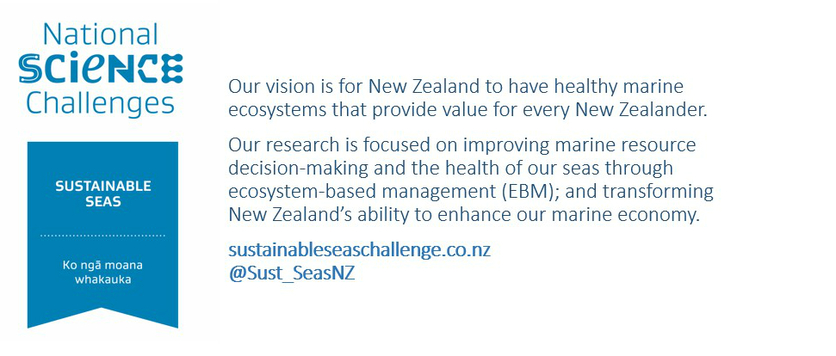The Kaituna River flows through the Bay of Plenty, winding its way from Lakes Rotorua and Rotoiti to its outflow at Te Tumu. However, Te Tumu is not the natural river mouth. Originally, the river flowed into the Ōngātoro/Maketū Estuary.
Te Tumu Cut was created in 1956 to help with flood control. Engineers dug a channel (cut) to shorten the river and divert it to the Pacific Ocean. Other large-scale projects straightened the river, created stopbanks, and drained the land to open it up for farming. Because less water flowed into the estuary, the ecosystem declined. For local Māori, the river and its estuary lost its mauri, and the people lost traditional harvest areas for kai awa and kaimoana.
In 2009, iwi, hapū, local government and other stakeholders agreed to partially redivert the river and restore the Ōngātoro/Maketū Estuary. Their vision is “to ensure that as a wider community our policies and plans, our activities and actions celebrate and honour Kaituna River and Ongatoro/Maketū Estuary life as taonga – Whakanuia, whakamawawatia te mauri o te Kaituna me Ongatoro hei taonga”.
Bay of Plenty Regional Council looked at many different options and continues to consult with interested parties. Construction work began in June 2018, and the project is due to be completed by June 2020. It has been a long process to create and implement the plans, but participatory management and co-governance have added to its success.
Communities who are affected need to be included as it leads to better, more effective decision making. It also enhances the likelihood of successful implementation.
Dr Patrick Barrett, University of Waikato
Participatory processes
As a country, our thinking about decision making has seen major shifts in recent times. We’re increasingly recognising that cultural and environmental considerations play an important part in how we manage and use the land and the sea.
Inclusive decision making may make the process more complex, but it also enables a broader acceptance of decisions that are made. This acceptance is referred to as a social licence to operate.
Sustainable Seas National Science Challenge
The Sustainable Seas National Science Challenge is tasked with helping Aotearoa New Zealand enhance the value of our marine resources while ensuring they are safeguarded for future generations. Research within the challenge aims to build new ways for people to be involved in making decisions about our marine estate.
Social scientist Dr Patrick Barrett and a team of researchers investigated why the Ōngātoro/Maketū Estuary restoration project has been so successful. They found that the participatory planning process encouraged shared learning among the different groups. Different types of knowledge – including mātauranga Māori, marine science and engineering – were all recognised and valued.
The research team noted that, when local traditional knowledge was incorporated into the technical designs, the outcomes were more effective. Their findings suggest that scientists and engineers who work within the participatory process can be more effective when they behave as facilitators rather than experts.
Now that some of the success factors have been identified, they can be applied to other situations that involve iwi and community groups. Together, all parties can work to build social licence within their local marine context.
Nature of science
Scientific knowledge has long influenced society in areas such as agriculture, engineering and medicine. Society, in turn, influences aspects of science. When scientists actively try to understand local communities, people feel their values are taken into account and may be more willing to accept or incorporate scientific knowledge.
National Science Challenges update
Related content
The Hub has extensive resources on estuaries. A good place to start is with the article Estuaries – a context for learning. It has links to resources that cover biological and ecological functions, cultural and economic aspects, geological and geographical features and human impacts on estuaries.
The activity Environmental thinking and planning with ecosystem-based management (EBM) offers students the opportunity to actively explore co-governance and participatory practices as they develop a management strategy for a local area or project.
Sustainable Seas collection
See the range of content that we have developed using resources from the Sustainable Seas National Science Challenge in this handy collection. Learn how to create, use and share collections here.
Useful links
Participatory processes for marine ecosystem restoration is one of the 40 research projects that make up the Sustainable Seas National Science Challenge Ko ngā moana whakauka.
Bay of Plenty Regional Council has media links, videos and more about the Kaituna River rediversion and Maketū Estuary enhancement project.
Watch the video Restoring the mauri of Te Awa o Ngātoroirangi about the Kaituna rediversion construction process.
Read more about Te Maru o Kaituna River Authority – a co-governance partnership involved with the Kaituna River rediversion. The Authority has created the document Kaituna he taonga tuku iho – a treasure handed down.
The Sustainable Seas Challenge has created a set of cards that introduce key elements of kaitiakitanga. The 11 Hui-te-ana-nui: Kaitiakitanga cards are available to download here. If you would like hard copies of the cards please contact sustainableseasNC@niwa.co.nz. Sustainable Seas notes that the content included in the summaries remain under the guardianship of the original knowledge sources.
Acknowledgement
This article has been developed using resources from the Sustainable Seas National Science Challenge. The Science Learning Hub also acknowledges the Bay of Plenty Regional Council Toi Moana for the use of a number of images.





